Déjà vu Again – Spotlight on the Soviet Forces of the Eastern Front Compilation

By Jim Naughton
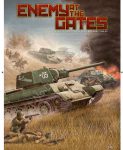
Four years and forty days ago (approximately) Battlefront continued its Mid-War Journey by introducing Enemy at the Gates and Iron Cross, bringing the Eastern Front to life in Version Four. A few short months later these books were complemented by Red Banner and Ghost Panzers. It would take two further years to see Finns, Rumanians, and Hungarians as BF focused on its Late War Journey.
Accompanying those four books were two Firestorm Campaigns. Our group played both campaigns and continued to play East Front Flames of War up to the release of Fortress Europe. It was a good run.
The newest release from Battlefront combines eight smaller books – four for the primary antagonists, 3 allies, and one for German paratroopers. The German paratroopers’ separate book is consolidated into the Ghost Panzers chapter, giving the new book seven chapters. Others will give you an overview of the big volume or focus on the Axis forces. My task is to highlight the Soviets – what’s changed, and what stayed the same. One thing absent from the compilation is the rules on City Fighting and Airborne Assault found in the originals.
To do this task I dusted off my copies of Enemy at the Gates and Red Banner, as well as the command card sets. One of my big worries with a reissue is that I’ll have to repurchase toys or game aids – I’ve been burned by other game companies in that respect. Then I went page by page (and card by card) playing ‘Spot the Difference. I must take into account that there are new players joining our community and they quite possibly never invested in Mid-War. Or were only parenthetically interested in Soviets. So I’ll baseline the article by briefly discussing Enemy at the Gates as well as Red Banner.
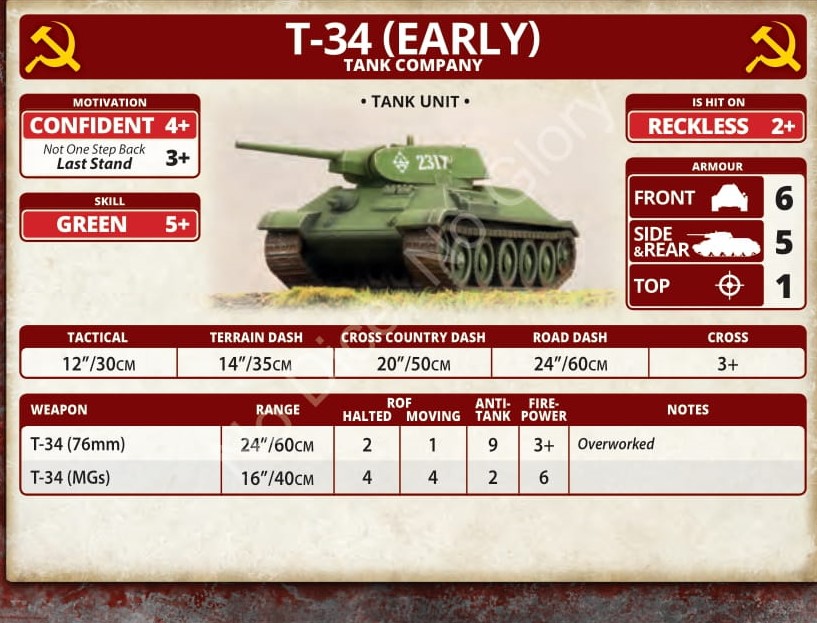
Enemy at the Gates is about the Stalingrad Campaign. The Force Diagram included a Mixed Tank Battalion, a T34(early) Tank Battalion, and an M3 (Lend Lease) Tank Battalion, as well as a Rifle Battalion and Hero Rifle Battalion. The Hero Rifle Battalions have smaller companies and worse morale than the Rifle Battalions. But Heroes have learned ‘duck and cover’ and thus have the normal infantry 3+ save. Support choices included flame tanks, towed tank killer companies, an enormous artillery park, scout cars, and the Shturmovik aircraft.
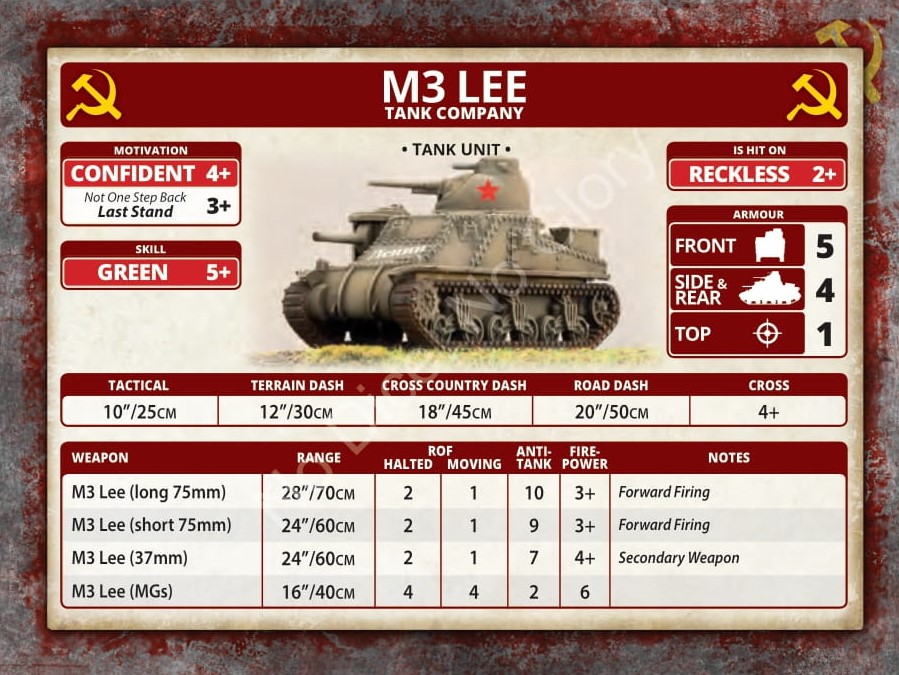
The armored vehicles included the T34(early), OT-34 (flame), T60, KV-1, KV-1s, KV-8 (flame), Valentine, M3 Grant, M3 Stuart, BA-10 armored car, DSHK AA Truck, and Katyusha.
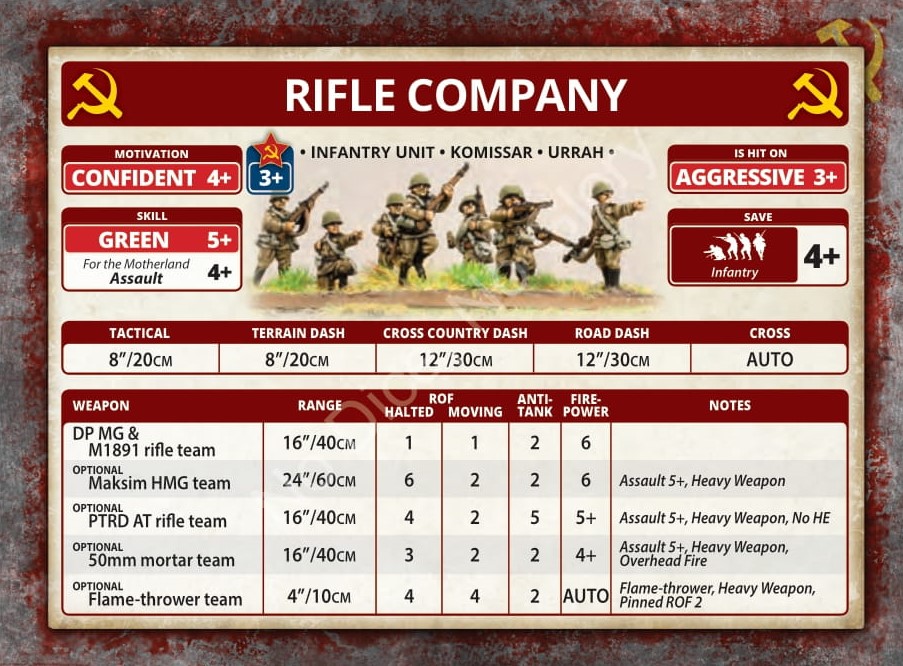
Infantry types included Rifles, Hero Rifles, Penal Troops, Storm Groups plus the usual assortment of mortars, scouts, and snipers. One eye-opener was the relative cost of T34(early) to the M3 Grant. Unlike the rest of the medium tank inventory, the Grants lack ‘Overworked’ – an attribute that makes tanks fire at +1 on the move. Another was the Rifle Company having a 4+ infantry save and a similar price per stand to the smaller Hero Rifle Company. As a result, most competitive armies fielded Lend-Lease medium tanks and Hero Rifles. The KVs held their own. And the Red God of War remained popular, although the difference in saves (4+ for artillery, 3+ for the same cannon operating as antitank guns) threw me for a while.
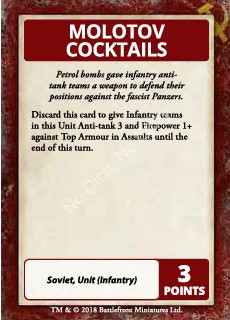
The companion Command Card Set included my personal favorite, Molotov Cocktails, the usual suspects like Lucky, and a very valuable card if playing a lot of artillery – Recon by Combat, allowing you to shift one of YOUR ranged in markers. Three heroes of note. Other cards enabled variant infantry formations – SMERSH, Guards, etc.
Red Banner moved the timeline to the summer of 1943. Big changes. The Lend-Lease tank inventory added two new models, a different variant of T34 (but still Overworked), T70, and a whole raft of SU-vehicles joined the party – mostly as support choices.
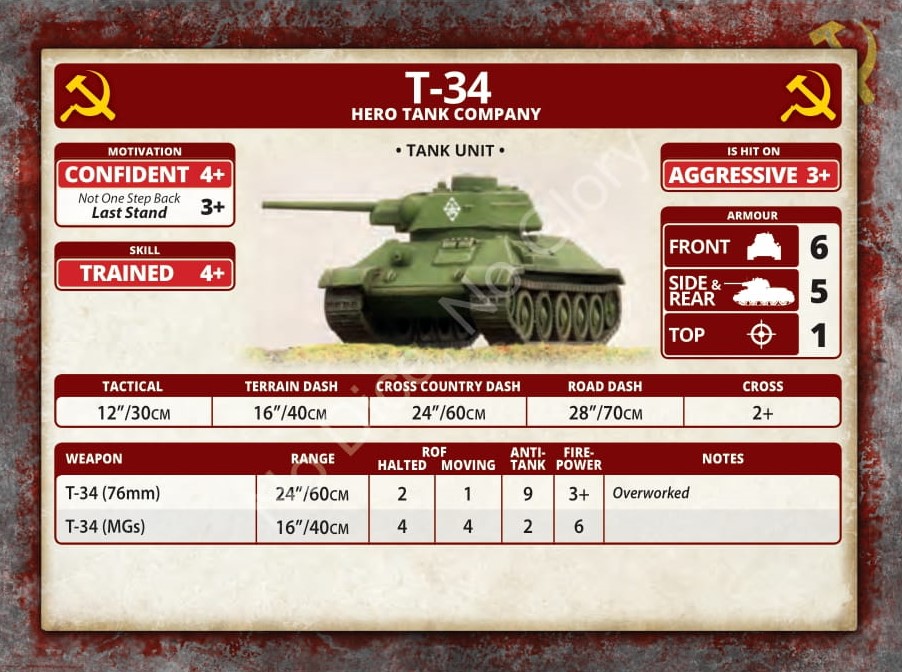

The formations of the Red Banner Force included T34 Battalion, Hero T34 Battalion, Guards Heavy Tank Regiments, Motor Rifle Battalions, Hero Motor Rifle Battalions, and my stalwart: the Reconnaissance Company. The new support choices included SU-76, SU-85, SU-122, and SU-152. The T34 variant brought better dash speeds but the higher cost and was still overworked, so never was a popular choice. The Motor Rifles have extra DPMGs and thus a ROF of 2/2. Guards and Hero Tank Companies are limited to three tanks and hit on 3+ (Aggressive) instead of 2+ (Reckless).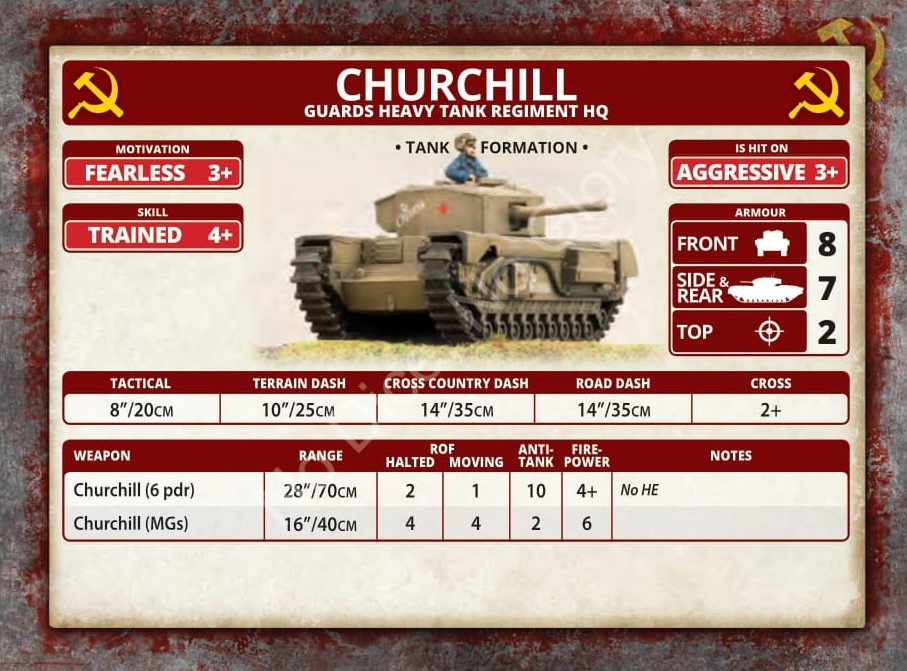
New models included the four SU-series vehicles, plus the T34 variant, and the T70. Also available were the Lend Lease Churchill, and the Lend-Lease Valentine VIII with 6-pounder gun. Command cards enabled variant formations such as Tank-killer regiments or various recon companies and offered the T34/57 variant. A couple of new heroes including a pricey Shturmovik pilot that actually can hit with bombs…mine racked up 3 Panthers, two Mark IIIs, a Mark IV, and several Marders; coming up short only on Ferdinands and Tigers.
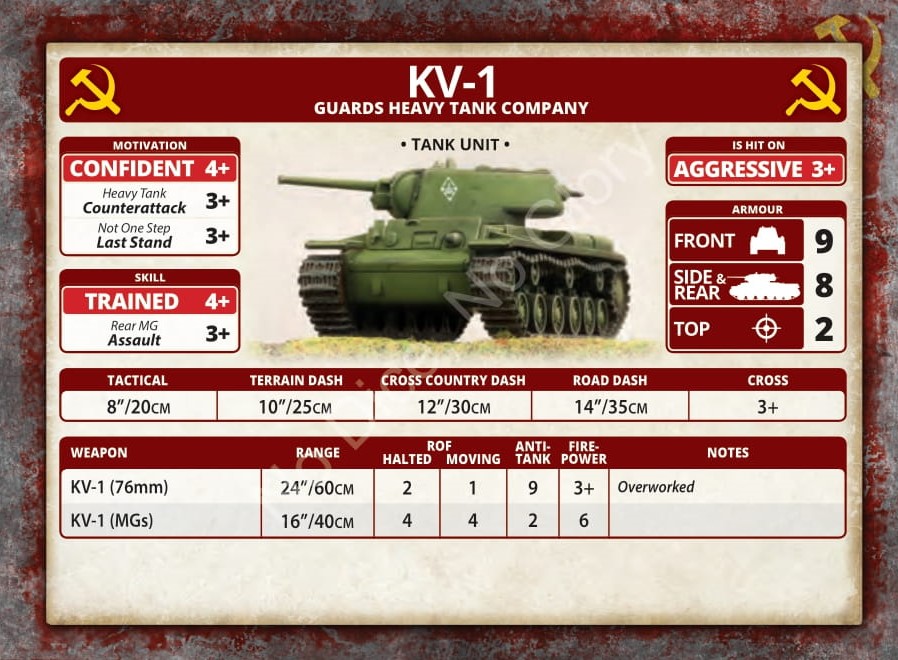
The Red Banner force diagram explicitly included the Enemy at the Gates formations, so only players wedded to the heroes of Stalingrad played forces based from that book.
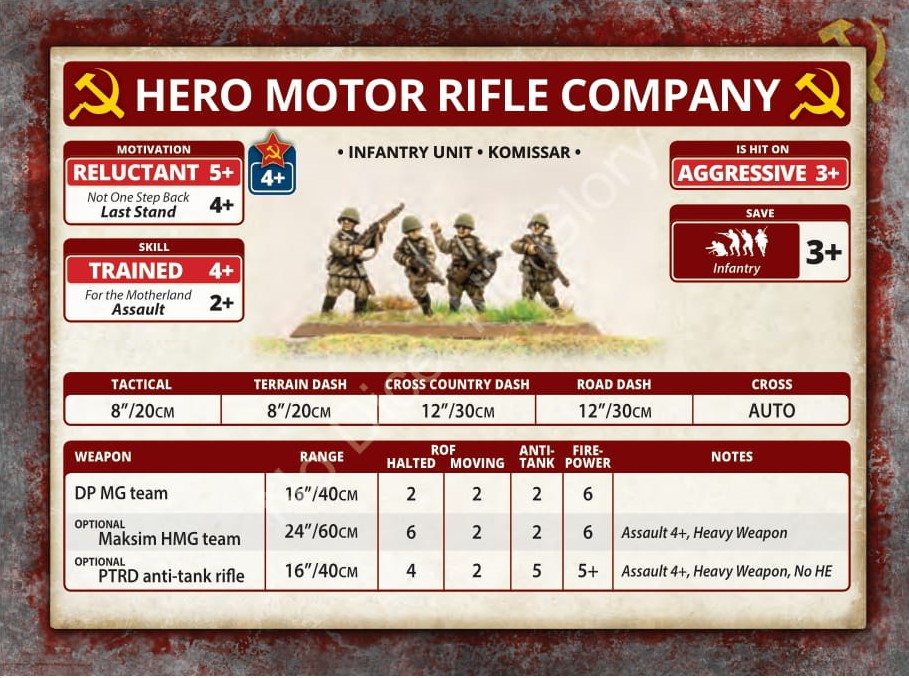
Such was the state of affairs when we moved on to Late War.
Eastern Front Midwar Forces is Battlefront’s compilation of what has gone before, with a few new twists. The Soviet section is last in the compilation and still divided into two chapters. Instead of two separate Know Your Tanks sections, a single section is found in Enemy At the Gates. Also, the Soviet special abilities (and some not so special) are all concentrated in Enemy At the Gates. The campaign narratives remain split between the appropriate sections.
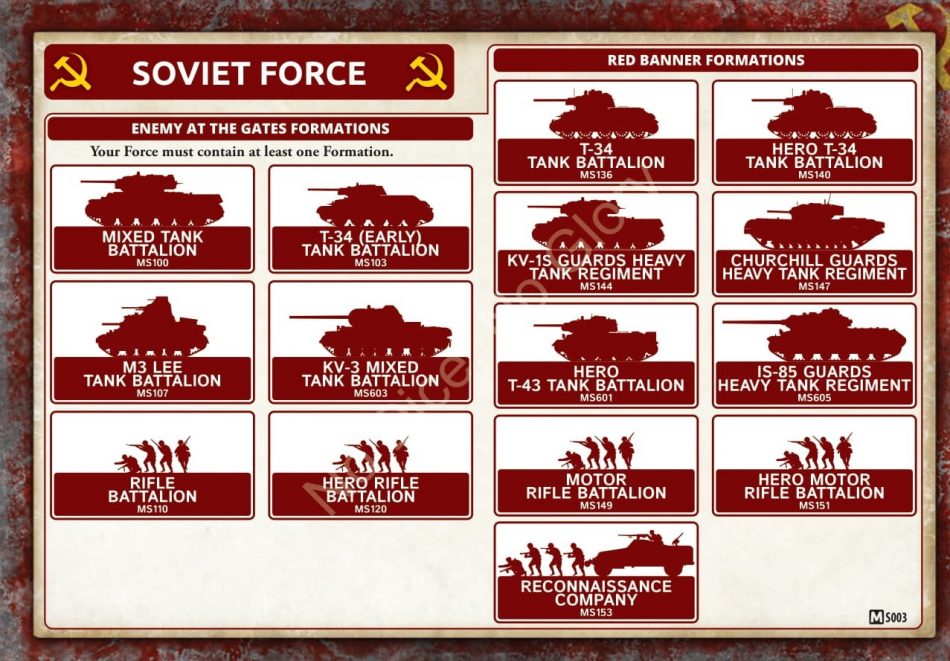
The Command Card decks remain the same. However, a big difference is found in the Force Diagram. Both Enemy at the Gates forces and Red Banner share the same array of support units. Originally, an Enemy at the Gates force had no access to the SU-series assault guns. Annoying, because choosing some of the Enemy at the Gates command cards could leave you vulnerable to the dreaded Tiger…most of the Soviet tanks can’t penetrate it, even from the side (75mm/76mm typically have AP=9 to the Tiger’s SA=8).
A second twist in Enemy at the Gates’ chapter is the KV-3. The KV-3 continues the trend of including tanks designed but not actually built/fielded during the war. It had a prototype driven a few miles before the invasion. The disruption and relocation of the Leningrad tank production lines effectively killed the project.
BF gives you the option to field a company in a new formation, the KV-3 Mixed Tank Battalion. The Mixed Battalion gives you a single KV heavy tank company, a medium tank company featuring T34 (early), Valentines, T60s or T70s, and ‘light’ tank company featuring Valentines, T60s or T70s, or Stuarts. Like the Mixed Tank Battalion found in the original Enemy at the Gates force diagram, this battalion has no headquarters.
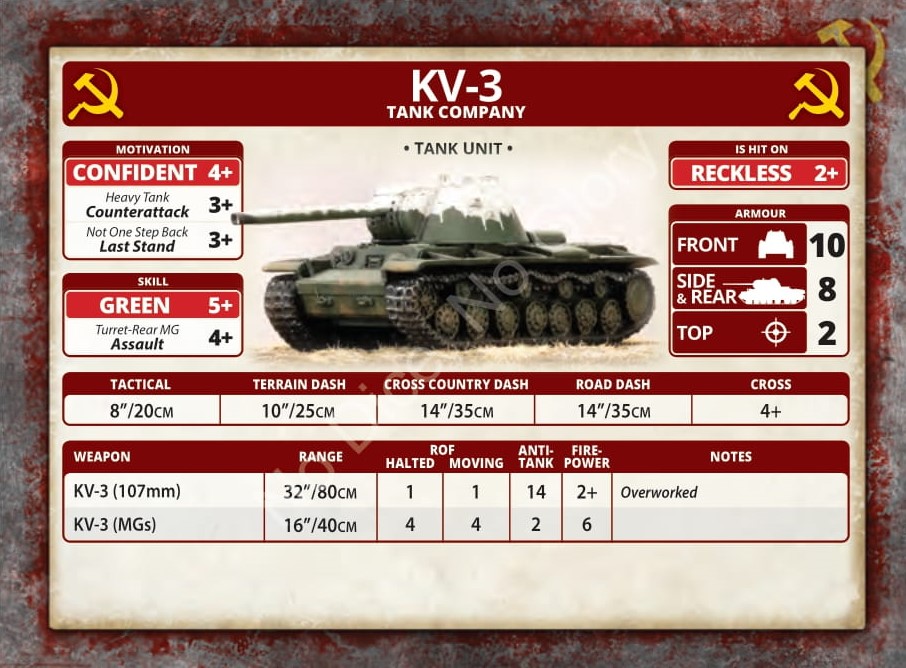
The KV-3’s AP cost is roughly two KV-3 for what the Soviets normally pay for three KV-1/KV-1S. The KV-3 is essentially equivalent to the Tiger in capability – AP=14 ROF=1 from its 107mm gun, FA=10. Like the Tiger, the KV-3 is unlikely to succumb to a swarm of lesser tanks if its flank is protected by infantry or antitank guns, making the Ferdinand, Panther, and Tiger its only rivals on the tabletop. Unfortunately, it’s afflicted by Overworked.
The next chapter in Eastern Front is Red Banner. The campaign vignettes cover the summer and fall battles of 1943. The same formations found in the original release populate the Force Diagram, but with two additions – one real, one a dream.
The T-43 Hero Medium Tank Battalion depicts the T43 tank, an uparmored T34 with a roomier turret. Intended for summer fielding, the delays caused by teething problems pushed the production back. Then Kursk revealed the Panther’s ability to shed the shot from the extant 76mm guns. The T-43 fell by the wayside as Soviet engineers focused on putting an 85mm gun into the T34. A modified T43 turret would become the basis of the T34/85.
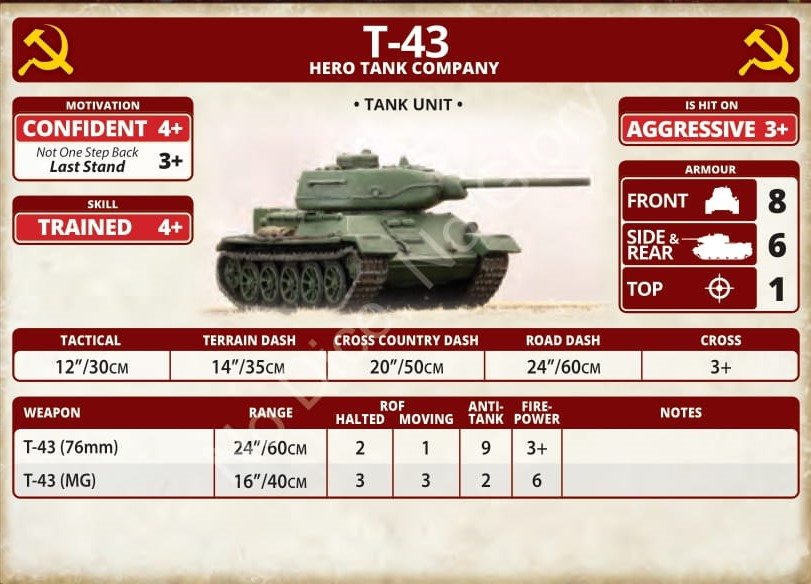
BF’s what-if representation depicts a tank with FA=8 and SA=6, the 76mm gun without being Overworked, and puts it in a Hero Battalion. Unlike the other Hero Tank Companies, the T43 can field up to 10 tanks, but the AP cost is out of sight. The 3-pack T43 company costs 4 AP more than the comparable T34 Hero company, a steep price differential for a tank that still doesn’t reliably survive fire from Marders, Panthers, or Tigers.
Unlike the T43, the IS-85 was real. The official designation was IS-1. It served as the bridge between the KV lines and JS lines of heavy tanks. It was fielded to three Heavy Tank Regiments before production was shifted to the IS-2. The fielding occurred in late fall, 1943 and the combat debut wasn’t until winter, 1944. It mounts the 85mm cannon in a IS-series hull, with FA=10 and SA=8. BF takes a minor liberty in offering us this tank in 1943. In actuality, the KV-85 (IS-85 turret on essentially a KV-1 hull) preceded it and saw some combat in 1943. There would be little game difference in performance between the two and so little point to two models.
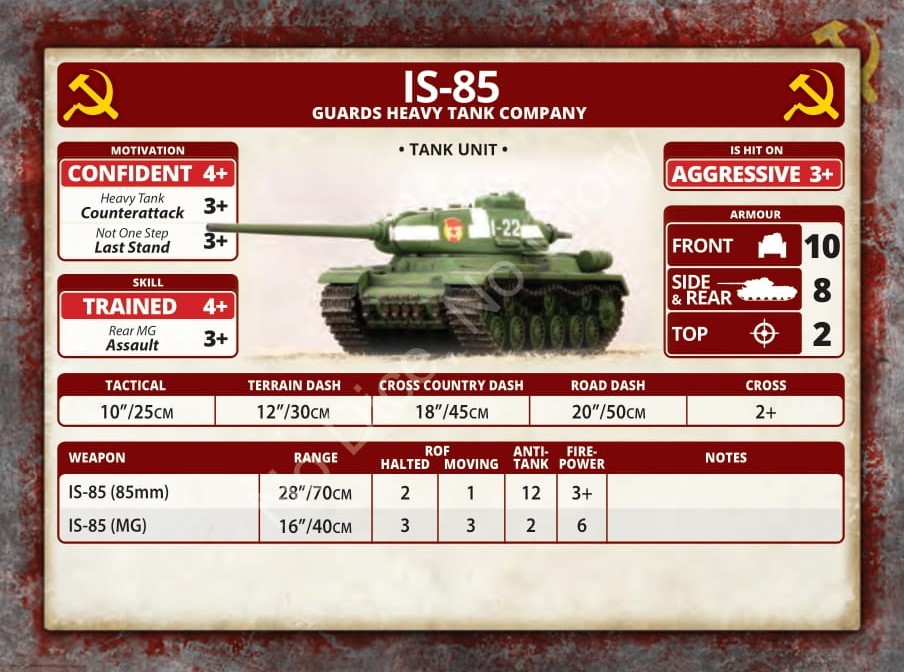
The AP cost of IS-85 is steep, with two models costing as much as four Churchills or three SU-85. Or three companies of Hero Valentines.
The last twist in Red Banner is the sole entry in the Soviet Wild Card category. A box for a Wild Card has existed in the Force Diagrams since the first V4 books, but until North Africa we had little use for them. Red Banner continues the trend of using it as a speculative tool, adding the monstrous KV-5 tank to the Soviet kit. Like its little brother the KV-3, the project died in the transfer of the design team to the Urals and the urgency of getting tanks that were ‘good enough’ into the field quickly.

The design weight was 100 tons, and the KV-5 has all the features a Soviet player would love – 107mm gun with ROF=2, not Overworked, FA=14, SA=10! Minor fly in the ointment – cross-check is 5+. A turret-rear MG, a feature of the KV line of tanks, gives it a 4+ assault rating. Pretty awesome, but the AP price tag is stunning, too – a pair of KV-5s costs a little more than three Guards KV-1. But for the first time, the Soviets can challenge Ferdinands and Tigers.
Now the toys. The original publication highlighted boxed sets Nikolai’s Steel Wall and Kutusov’s Heroes. Bid them Dospidania. There are new boxed sets – Hero Rifle Battalion and Red Banner Tank Battalion. Both are great values if you’re starting an army.
You also can enter the fray with Stalingrad and Kursk starter sets, which provide both sides of the named battles. Again, great values, particularly if you are uncertain what army you want to play. Also, the good news is that most of these kits (like 90 percent) transfer to Late War.
The new Soviet tanks – KV-3, KV-5, T43, and IS-85 – are all packaged in pairs. The IS-85 is billed as ‘all plastic.’ It is probably a IS-II plastic kit, as I recall back in the mists of time the old IS-II kit had the parts for the IS-85. Have to wait for an unboxing video to confirm. The others apparently are resin/metal.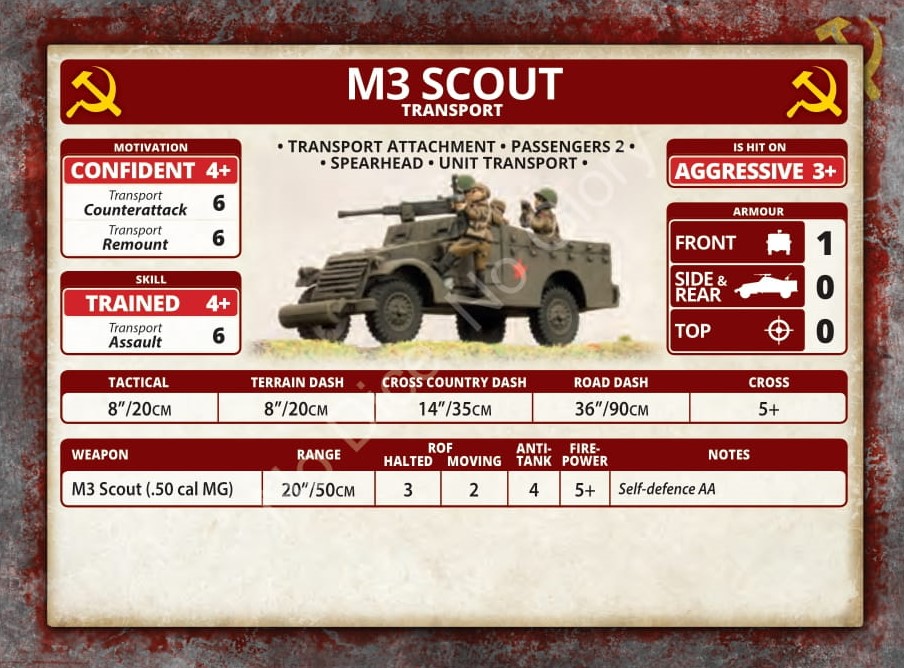
As a relatively experienced Soviet player (in addition to running two campaigns and participating in same I played mid-war Soviets in local tournaments until Fortress Europe switched the meta) I’m happy with the compilation book, but I don’t see the new tanks changing much. A Soviet infantry army might seek the new heavy tanks to neutralize the enemy’s big tanks, but Soviet armies have been competitive despite having to struggle with Panthers, Tigers, and Ferdinands. As an inveterate modeler I’ll probably collect the new tanks as a hedge against being wrong about their impact, but don’t expect to use them much. KV-8s, Reconnaissance Companies, and Valentines will remain my stalwarts. к победе!

Jim Thanks for the trip down memory lane and the info on the new book.
Nicely written and presented Jim. Thank you for the update and insight
Thanks, Recce. Hope the information helps guide your planning
Nice article, Jim!